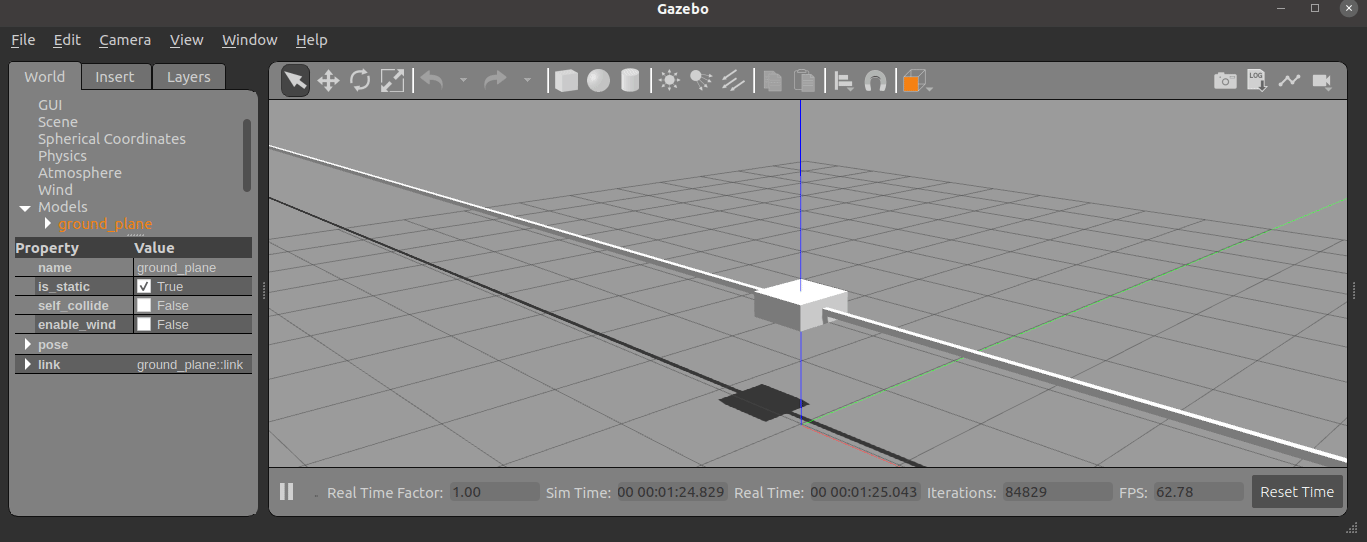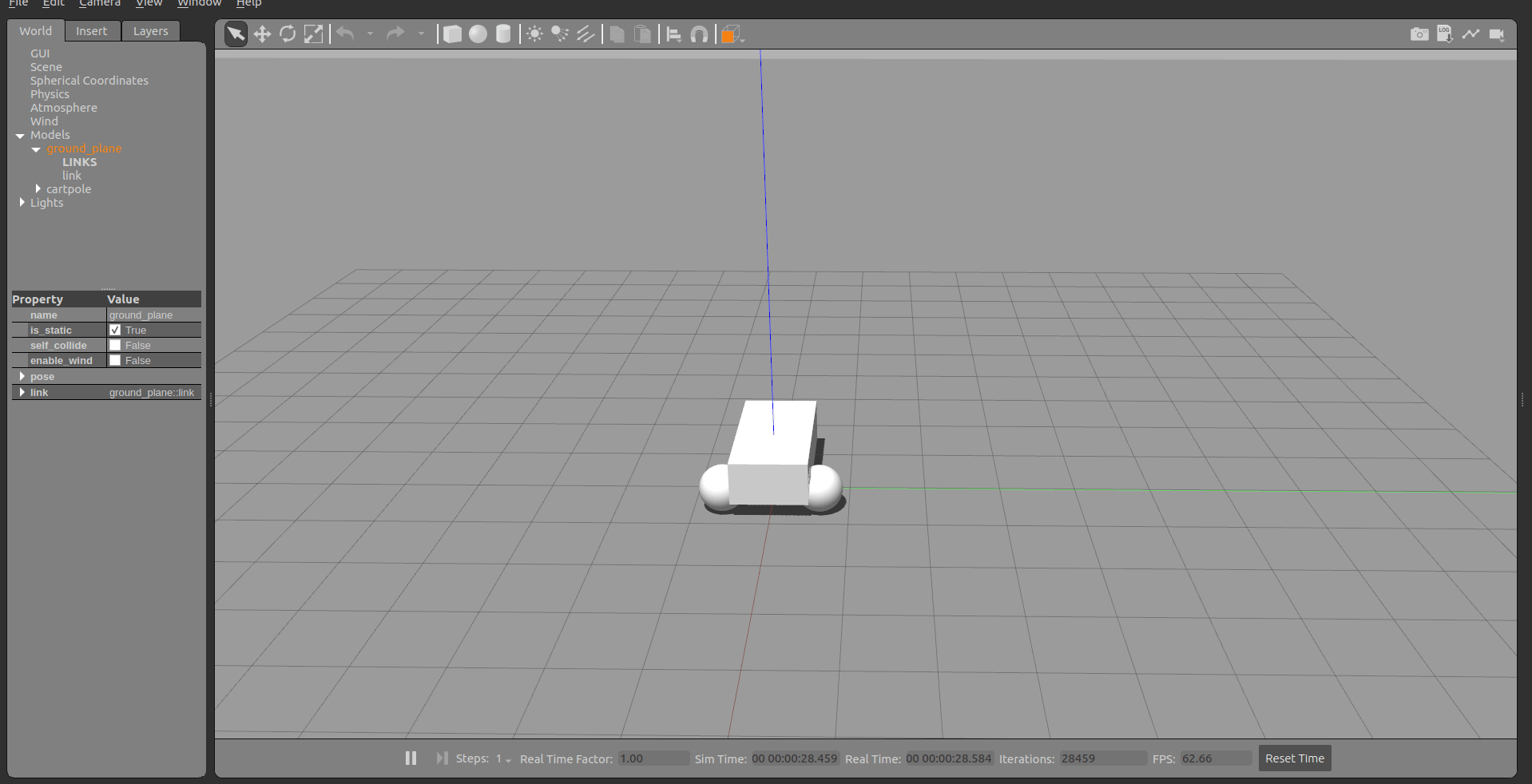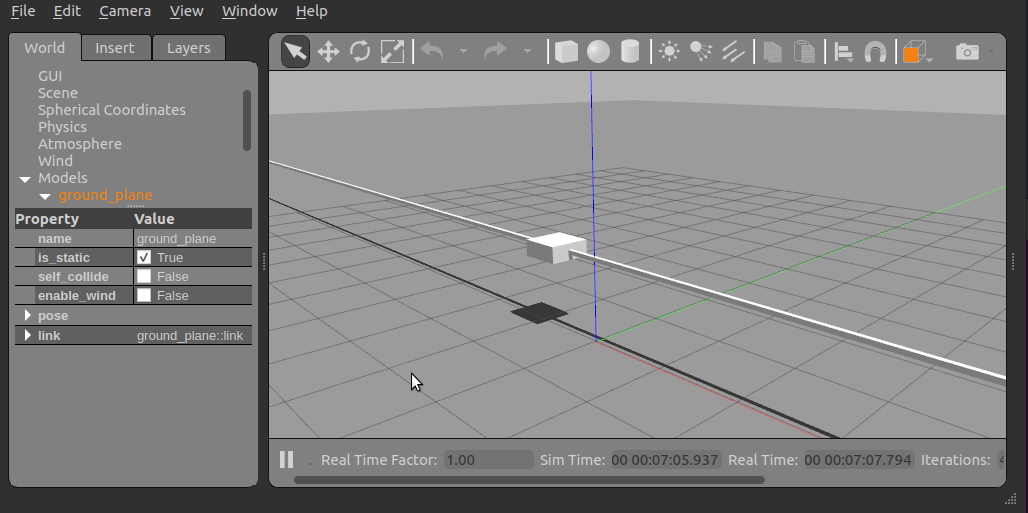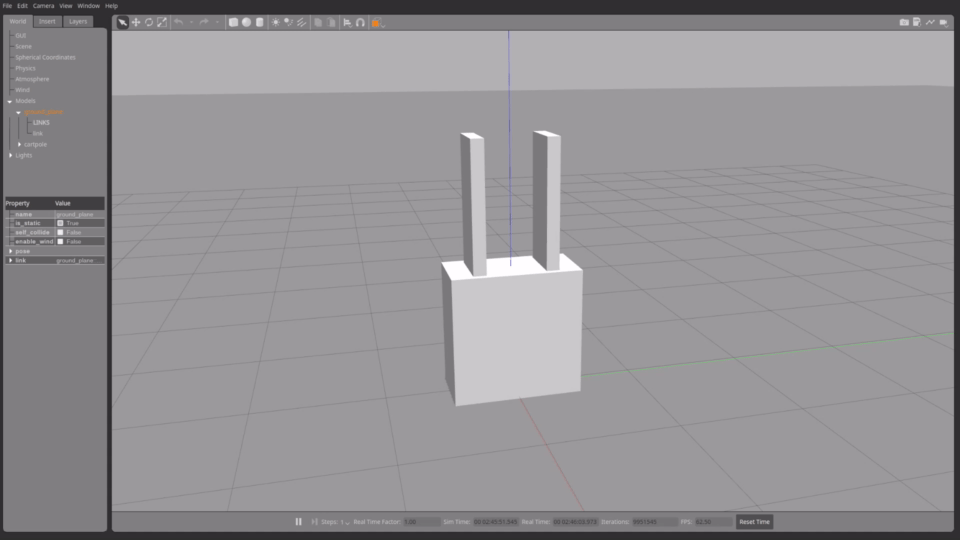
|
gazebo_ros2_control repositoryros gazebo ros2 gazebo-classic gazebo_ros2_control gazebo_ros2_control_demos |
|
|
Repository Summary
| Description | Wrappers, tools and additional API's for using ros2_control with Gazebo Classic |
| Checkout URI | https://github.com/ros-simulation/gazebo_ros2_control.git |
| VCS Type | git |
| VCS Version | humble |
| Last Updated | 2025-05-18 |
| Dev Status | DEVELOPED |
| CI status | No Continuous Integration |
| Released | RELEASED |
| Tags | ros gazebo ros2 gazebo-classic |
| Contributing |
Help Wanted (0)
Good First Issues (0) Pull Requests to Review (0) |
Packages
| Name | Version |
|---|---|
| gazebo_ros2_control | 0.4.11 |
| gazebo_ros2_control_demos | 0.4.11 |
README
gazebo_ros2_control
This is a ROS 2 package for integrating the ros2_control controller architecture with the Gazebo Classic simulator.
Gazebo Classic went end-of-life in January of 2025. There won’t be any updates to gazebo_ros2_control anymore.
We strongly recommend all users migrate from Gazebo Classic (numbered releases) to modern Gazebo (formerly known as Ignition 3, lettered releases). To use ros2_control with newer versions of Gazebo take a look at gz_ros2_control.
Furthermore, Gazebo Classic is not released to Ubuntu Noble. As a consequence, gazebo_ros2_control never was released to Jazzy and Rolling/Noble.
This package provides a Gazebo plugin which instantiates a ros2_control controller manager and connects it to a Gazebo model.
Documentation
See the documentation file or control.ros.org.
Build status
| ROS 2 Distro | Branch | Build status | Documentation |
|---|---|---|---|
| Rolling | master |
Documentation | |
| Jazzy | master |
Documentation | |
| Humble | humble |
Documentation |
CONTRIBUTING

|
gazebo_ros2_control repositoryros gazebo ros2 gazebo-classic gazebo_ros2_control gazebo_ros2_control_demos |
|
|
Repository Summary
| Description | Wrappers, tools and additional API's for using ros2_control with Gazebo Classic |
| Checkout URI | https://github.com/ros-simulation/gazebo_ros2_control.git |
| VCS Type | git |
| VCS Version | galactic |
| Last Updated | 2022-11-25 |
| Dev Status | DEVELOPED |
| CI status | No Continuous Integration |
| Released | RELEASED |
| Tags | ros gazebo ros2 gazebo-classic |
| Contributing |
Help Wanted (0)
Good First Issues (0) Pull Requests to Review (0) |
Packages
| Name | Version |
|---|---|
| gazebo_ros2_control | 0.2.0 |
| gazebo_ros2_control_demos | 0.2.0 |
README
gazebo_ros2_control
| ROS2 Distro | Build Status | Package build |
|---|---|---|
 |
This is a ROS 2 package for integrating the ros2_control controller architecture with the Gazebo simulator.
This package provides a Gazebo plugin which instantiates a ros2_control controller manager and connects it to a Gazebo model.
Usage
This repository contains the contents for testing gazebo_ros2_control
It is running Gazebo and some other ROS 2 nodes.
Video + Pictures


Running
Modifying or building your own
cd Docker
docker build -t gazebo_ros2_control .
To run the demo
Using Docker
Docker allows us to run the demo without GUI if we don’t configure it properly. The following command runs the demo without GUI:
docker run -it --rm --name gazebo_ros2_control_demo --net host gazebo_ros2_control ros2 launch gazebo_ros2_control_demos cart_example_position.launch.py gui:=false
The in your local machine you can run the Gazebo client:
gzclient
Using Rocker
To run the demo with GUI we are going to use rocker which is a tool to run docker images with customized local support injected for things like nvidia support. And user id specific files for cleaner mounting file permissions. You can install this tool with the following instructions.
The following command will launch Gazebo:
rocker --x11 --nvidia --name gazebo_ros2_control_demo gazebo_ros2_control:latest
The following commands allow to move the cart in the rail:
docker exec -it gazebo_ros2_control_demo bash
source /home/ros2_ws/install/setup.bash
ros2 run gazebo_ros2_control_demos example_position
Add ros2_control tag to a URDF
To use ros2_control with your robot, you need to add some additional elements to your URDF.
You should include the tag <ros2_control> to access and control the robot interfaces. We should
include
- a specific
<plugin>for our robot -
<joint>tag including the robot controllers: commands and states.
<ros2_control name="GazeboSystem" type="system">
<hardware>
<plugin>gazebo_ros2_control/GazeboSystem</plugin>
</hardware>
<joint name="slider_to_cart">
<command_interface name="effort">
<param name="min">-1000</param>
<param name="max">1000</param>
</command_interface>
<state_interface name="position"/>
<state_interface name="velocity"/>
<state_interface name="effort"/>
</joint>
</ros2_control>
Using mimic joints in simulation
To use mimic joints in gazebo_ros2_control you should define its parameters to your URDF.
We should include:
-
<mimic>tag to the mimicked joint ([detailed manual(https://wiki.ros.org/urdf/XML/joint)) -
mimicandmultiplierparameters to joint definition in<ros2_control>tag
<joint name="left_finger_joint" type="prismatic">
<mimic joint="right_finger_joint"/>
<axis xyz="0 1 0"/>
<origin xyz="0.0 0.48 1" rpy="0.0 0.0 3.1415926535"/>
<parent link="base"/>
<child link="finger_left"/>
<limit effort="1000.0" lower="0" upper="0.38" velocity="10"/>
</joint>
<joint name="right_finger_joint" type="prismatic">
<axis xyz="0 1 0"/>
<origin xyz="0.0 -0.48 1" rpy="0.0 0.0 0.0"/>
<parent link="base"/>
<child link="finger_right"/>
<limit effort="1000.0" lower="0" upper="0.38" velocity="10"/>
</joint>
<ros2_control name="GazeboSystem" type="system">
<hardware>
<plugin>gazebo_ros2_control/GazeboSystem</plugin>
</hardware>
<joint name="right_finger_joint">
<command_interface name="position"/>
<state_interface name="position"/>
<state_interface name="velocity"/>
<state_interface name="effort"/>
</joint>
<joint name="left_finger_joint">
<param name="mimic">right_finger_joint</param>
<param name="multiplier">1</param>
<command_interface name="position"/>
<state_interface name="position"/>
<state_interface name="velocity"/>
<state_interface name="effort"/>
</joint>
</ros2_control>
Add the gazebo_ros2_control plugin
In addition to the ros2_control tags, a Gazebo plugin needs to be added to your URDF that
actually parses the ros2_control tags and loads the appropriate hardware interfaces and
controller manager. By default the gazebo_ros2_control plugin is very simple, though it is also
extensible via an additional plugin architecture to allow power users to create their own custom
robot hardware interfaces between ros2_control and Gazebo.
<gazebo>
<plugin filename="libgazebo_ros2_control.so" name="gazebo_ros2_control">
<robot_param>robot_description</robot_param>
<robot_param_node>robot_state_publisher</robot_param_node>
<parameters>$(find gazebo_ros2_control_demos)/config/cartpole_controller.yaml</parameters>
</plugin>
</gazebo>
The gazebo_ros2_control <plugin> tag also has the following optional child elements:
-
<robot_param>: The location of therobot_description(URDF) on the parameter server, defaults torobot_description -
<robot_param_node>: Name of the node where therobot_paramis located, default torobot_state_publisher -
<parameters>: YAML file with the configuration of the controllers
Default gazebo_ros2_control Behavior
By default, without a <plugin> tag, gazebo_ros2_control will attempt to get all of the information it needs to interface with a ros2_control-based controller out of the URDF. This is sufficient for most cases, and good for at least getting started.
The default behavior provides the following ros2_control interfaces:
- hardware_interface::JointStateInterface
- hardware_interface::EffortJointInterface
- hardware_interface::VelocityJointInterface
Advanced: custom gazebo_ros2_control Simulation Plugins
The gazebo_ros2_control Gazebo plugin also provides a pluginlib-based interface to implement custom interfaces between Gazebo and ros2_control for simulating more complex mechanisms (nonlinear springs, linkages, etc).
These plugins must inherit gazebo_ros2_control::GazeboSystemInterface which implements a simulated ros2_control
hardware_interface::SystemInterface. SystemInterface provides API-level access to read and command joint properties.
The respective GazeboSystemInterface sub-class is specified in a URDF model and is loaded when the robot model is loaded. For example, the following XML will load the default plugin:
<ros2_control name="GazeboSystem" type="system">
<hardware>
<plugin>gazebo_ros2_control/GazeboSystem</plugin>
</hardware>
...
<ros2_control>
<gazebo>
<plugin name="gazebo_ros2_control" filename="libgazebo_ros2_control.so">
...
</plugin>
</gazebo>
Set up controllers
Use the tag <parameters> inside <plugin> to set the YAML file with the controller configuration.
<gazebo>
<plugin name="gazebo_ros2_control" filename="libgazebo_ros2_control.so">
<parameters>$(find gazebo_ros2_control_demos)/config/cartpole_controller.yaml</parameters>
</plugin>
<gazebo>
This controller publishes the state of all resources registered to a
hardware_interface::StateInterface to a topic of type sensor_msgs/msg/JointState.
The following is a basic configuration of the controller.
joint_state_controller:
ros__parameters:
type: joint_state_controller/JointStateController
This controller creates an action called /cart_pole_controller/follow_joint_trajectory of type control_msgs::action::FollowJointTrajectory.
cart_pole_controller:
ros__parameters:
type: joint_trajectory_controller/JointTrajectoryController
joints:
- slider_to_cart
write_op_modes:
- slider_to_cart
Executing the examples
There are some examples in the gazebo_ros2_control_demos package. These examples allow to launch a cart in a 30 meter rail.

You can run some of the configuration running the following commands:
ros2 launch gazebo_ros2_control_demos cart_example_position.launch.py
ros2 launch gazebo_ros2_control_demos cart_example_velocity.launch.py
ros2 launch gazebo_ros2_control_demos cart_example_effort.launch.py
ros2 launch gazebo_ros2_control_demos diff_drive.launch.py
ros2 launch gazebo_ros2_control_demos gripper_mimic_joint_example.launch.py
Send example commands:
When the Gazebo world is launched you can run some of the following commands to move the cart.
ros2 run gazebo_ros2_control_demos example_position
ros2 run gazebo_ros2_control_demos example_velocity
ros2 run gazebo_ros2_control_demos example_effort
ros2 run gazebo_ros2_control_demos example_diff_drive
ros2 run gazebo_ros2_control_demos example_gripper
The following example shows parallel gripper with mimic joint:

ros2 launch gazebo_ros2_control_demos gripper_mimic_joint_example.launch.py
Send example commands:
ros2 run gazebo_ros2_control_demos example_gripper
Gazebo + Moveit2 + ROS 2
This example works with ROS 2 Foxy. You should install Moveit2 from sources, the instructions are available in this link.
The repository with all the required packages are in the gazebo_ros_demos.
ros2 launch rrbot_moveit_demo_nodes rrbot_demo.launch.py

CONTRIBUTING

|
gazebo_ros2_control repositoryros gazebo ros2 gazebo-classic gazebo_ros2_control gazebo_ros2_control_demos |
|
|
Repository Summary
| Description | Wrappers, tools and additional API's for using ros2_control with Gazebo Classic |
| Checkout URI | https://github.com/ros-simulation/gazebo_ros2_control.git |
| VCS Type | git |
| VCS Version | iron |
| Last Updated | 2024-11-01 |
| Dev Status | DEVELOPED |
| CI status | No Continuous Integration |
| Released | RELEASED |
| Tags | ros gazebo ros2 gazebo-classic |
| Contributing |
Help Wanted (0)
Good First Issues (0) Pull Requests to Review (0) |
Packages
| Name | Version |
|---|---|
| gazebo_ros2_control | 0.6.8 |
| gazebo_ros2_control_demos | 0.6.8 |
README
gazebo_ros2_control
This is a ROS 2 package for integrating the ros2_control controller architecture with the Gazebo Classic simulator.
Gazebo Classic goes end-of-life in January of 2025. We strongly recommend all users migrate from Gazebo Classic (numbered releases) to modern Gazebo (formerly known as Ignition 3, lettered releases) before January 2025.
Furthermore, Gazebo Classic is not released to Ubuntu Noble. As a consequence, gazebo_ros2_control won’t be released for Jazzy and Rolling anymore.
To use ros2_control with newer versions of Gazebo take a look at gz_ros2_control.
This package provides a Gazebo plugin which instantiates a ros2_control controller manager and connects it to a Gazebo model.
Documentation
See the documentation file or control.ros.org.
Build status
| ROS 2 Distro | Branch | Build status | Documentation |
|---|---|---|---|
| Rolling | master |
n/a | Documentation |
| Jazzy | master |
n/a | Documentation |
| Iron | iron |
Documentation | |
| Humble | humble |
Documentation |